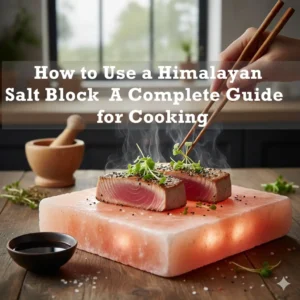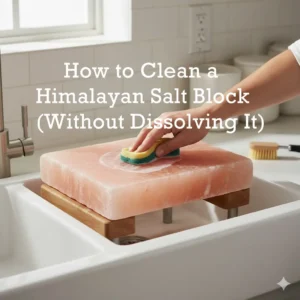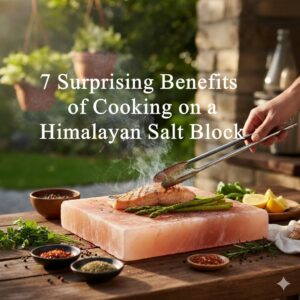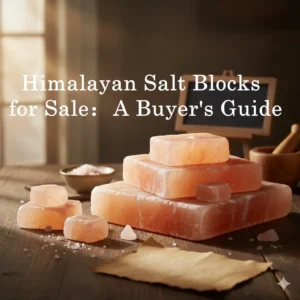Salt blocks—solid or cracked—are natural slabs of mineral-rich Himalayan salt used for cooking, curing, and presentation. Both share the same composition and antibacterial qualities, but their condition affects how they perform and what they’re best suited for. This article outlines the key differences between solid and cracked salt blocks, demonstrating their unique roles and helping you decide whether to repurpose a damaged block or replace it with a new one.
Cracked Salt Block vs. Solid Salt Block: Core Differences at a Glance
A cracked salt block retains its natural flavor and antimicrobial properties, but its altered structure changes how it performs in the kitchen. The chart below outlines the main distinctions, helping you decide when to repurpose broken pieces or rely on a solid block for more demanding cooking applications.
| Feature | Cracked Salt Block | Solid Salt Block |
|---|---|---|
| Shape and Integrity | Irregular, fragmented pieces less suited for large cooking surfaces | Uniform, intact slabs ideal for searing and grilling |
| Functionality | Well-suited for creative uses such as serving, curing, scrubs, and small-scale searing | Designed for direct-heat cooking methods including grilling, baking, and searing |
| Durability | Fragile and susceptible to further cracking but still functional in smaller pieces | Durable and long-lasting with proper care and storage |
| Aesthetic Appeal | Rustic appearance with a distinctive, natural character | Polished, consistent surface with refined visual appeal |
| Versatility | Adaptable for non-traditional roles such as bath salts, finishing salts, and decorative serving | Primarily culinary-focused with fewer secondary applications |
What Is a Cracked Salt Block? Creative Uses and Benefits
A cracked salt block typically forms after repeated heating cycles or during transport; however, its natural mineral composition and flavoring qualities remain unchanged. These fractures don’t reduce its functionality—rather, they create new opportunities for inventive reuse inside and outside the kitchen.
Larger fragments can serve as compact grilling or searing surfaces for scallops, meats, or vegetables. Flat sections work well as chilled platters for sushi, cheese, or fruit, while smaller chips can be incorporated into baked goods or used as the base for homemade bath salts and scrubs. The antimicrobial and mineral properties of the block remain equally effective, regardless of its shape.
Tiny pieces can also be ground into fine finishing salts to subtly season everyday dishes. Some users polish medium fragments into rustic soap dishes or shape them into cubes for chilling and presenting drinks. Each adaptive reuse extends the original block’s purpose and aesthetic character.
Repurposing cracked salt blocks turns what might seem like waste into a sustainable, multiuse resource. It’s a practical approach that reduces disposal, maximizes product longevity, and encourages thoughtful creativity in culinary and decorative applications.
Premium Himalayan Salt Blocks for Culinary and Hospitality
Source authentic pink Himalayan salt from the Khewra Mine with FDA and EU-certified food-grade quality. Customize size, shape, and packaging to meet your business needs while offering customers natural, mineral-rich flavor and refined presentation across food service, retail, and hospitality sectors.
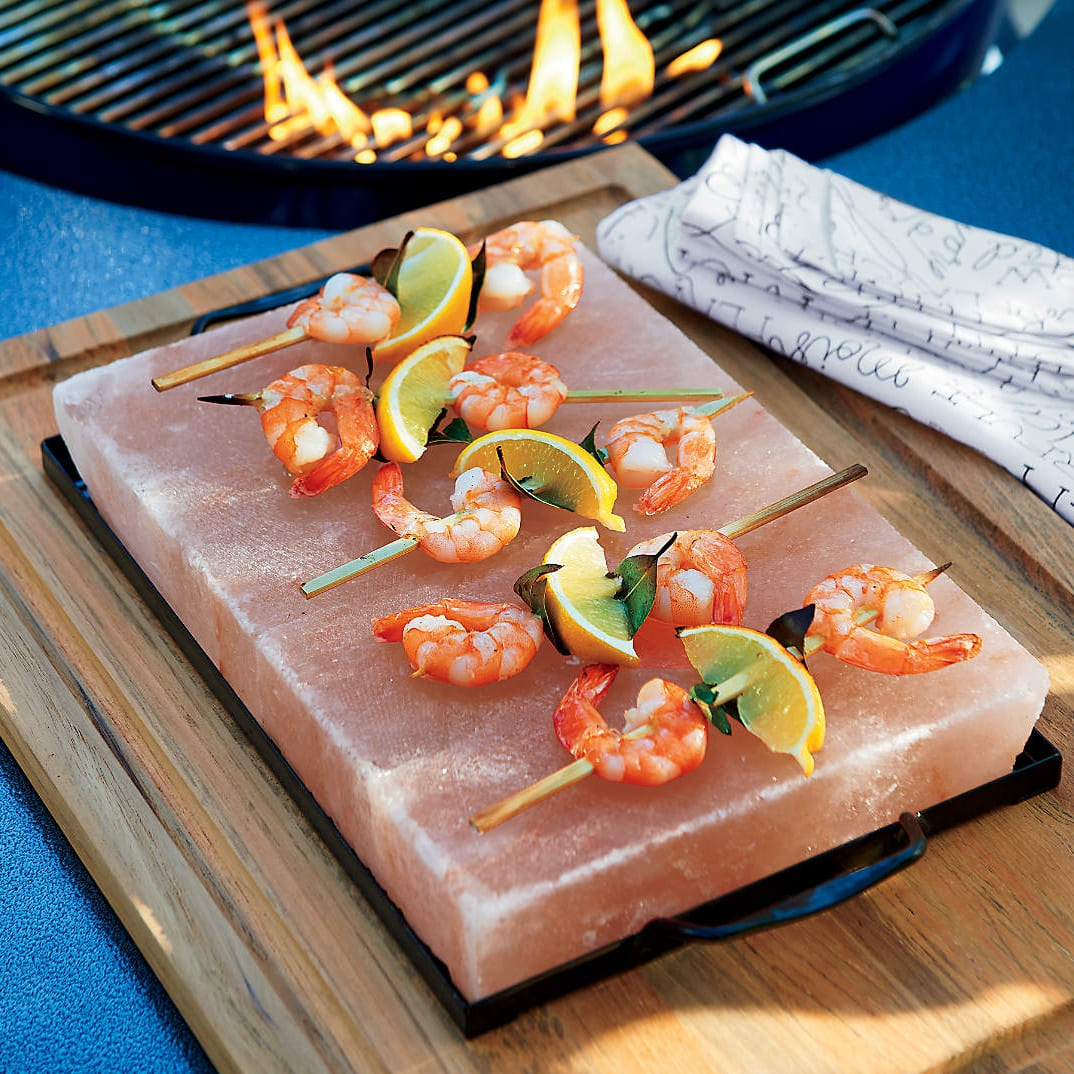
What Is a Solid Salt Block? Typical Uses and Advantages
A solid salt block is a single, intact slab carved from natural salt deposits, most commonly from Himalayan sources. Its smooth, polished surface distributes heat evenly, making it ideal for both high-temperature cooking and chilled serving applications. With proper care, it becomes a durable, long-term addition to any kitchen—suitable for use on grills, stovetops, or as a cold serving base.
Because salt retains and releases heat gradually, solid blocks excel at searing meats, grilling seafood, and roasting vegetables. The surface subtly seasons foods, enhancing flavor without over-salting. This combination of performance and precision has made salt blocks a trusted tool among both professional chefs and discerning home cooks.
Beyond functionality, these blocks elevate presentation. Their translucent pink hue adds a refined, natural aesthetic to any table setting. To prolong their life, simply wipe them clean after each use and keep them away from moisture. With minimal maintenance, a solid salt block can remain both a reliable cooking surface and a statement piece of kitchen craftsmanship.
Head-to-Head Showdown: Cracked Salt Block vs. Solid Salt Block
Performance and Culinary Versatility
Solid salt blocks provide consistently reliable performance under direct heat. They distribute temperature evenly, making them ideal for grilling steaks, seafood, or vegetables without hot spots. The unbroken surface also allows for confident heat retention and precise control during searing.
Cracked salt blocks, by contrast, excel in specialized applications. Their smaller sizes are effective for delicate tasks such as curing fish, chilling desserts, or preparing small searing portions. These pieces broaden culinary possibilities while preserving the same mineral-rich flavor and antimicrobial safety. The trade-off is the need for gentle handling to avoid additional fractures.
Cost Efficiency and Durability
Purchasing a solid salt block involves a higher initial cost but ensures a single, uniform slab capable of withstanding repeated heating and cooling when properly maintained. Minor cracks or chips may develop over time, yet attentive care can significantly extend the block’s functional lifespan.
When a block does crack, its usability doesn’t end. Repurposing the fragments turns potential waste into a valuable resource for daily cooking and presentation. Many cooks retain these pieces rather than replacing the block, promoting both cost efficiency and a more sustainable use of kitchen materials.
Design and Presentation Appeal
A solid block lends a refined, consistent appearance that suits professional kitchens or formal dining. Its polished surface and uniform tone highlight the inherent beauty of Himalayan salt and enhance the visual presentation of food.
Broken pieces, meanwhile, bring a distinctly artisanal touch. They serve as seasoning stones, drink chillers, or wellness features like mineral scrubs and bath salts. Each fragment reflects the block’s natural story, transforming breakage into an opportunity for creativity and thoughtful reuse.
Frequently Asked Questions About Using Broken Salt Block Pieces
Is it safe to cook with broken salt block pieces?
Yes. Broken salt block fragments remain safe for cooking provided they are clean and free of debris. Their natural antimicrobial properties are unaffected by cracks. Use the larger pieces for grilling, searing, or baking small portions.
How can I grind salt block fragments into finishing salt?
Place dry pieces in a mortar and pestle or a durable spice grinder. Crush them gradually until you reach a fine or coarse grain. Store the resulting salt in airtight glass jars to protect it from moisture and clumping.
Can a cracked salt block be repaired with glue or adhesive?
No. Repairing salt blocks with adhesive is unsafe, as glues can react to heat or moisture and contaminate food. Instead of rejoining the block, repurpose the fragments for curing, serving, or seasoning tasks.
What is the best way to prepare a brine using salt block pieces?
Use warm water to dissolve the salt evenly. Combine about one cup of small fragments with four cups of warm water and stir until the solution clears. The resulting brine can season meats, vegetables, or homemade pickles.
What are creative uses for very small salt chips?
Tiny salt chips work well for mineral-rich scrubs or bath soaks, adding texture and trace elements to skincare. They can also be displayed in jars or trays as natural decorative accents. Their strength lies in flexibility rather than size.
Final Thoughts
Both solid and cracked salt blocks offer distinct value depending on how you cook and present food. A solid block provides stability for high-heat searing and consistent flavor transfer, while cracked pieces invite creativity and resourceful reuse.
For those who enjoy hands-on cooking or inventive plating, smaller fragments are ideal for cold serving, curing, or decorative applications. Viewing a cracked block as a set of reusable tools extends its life and minimizes waste.
For dependable quality and mineral purity, source Himalayan salt blocks from reputable suppliers such as Jilin Ever Creation. Whether whole or in pieces, a well-crafted salt block continues to enrich both your culinary performance and presentation style.


